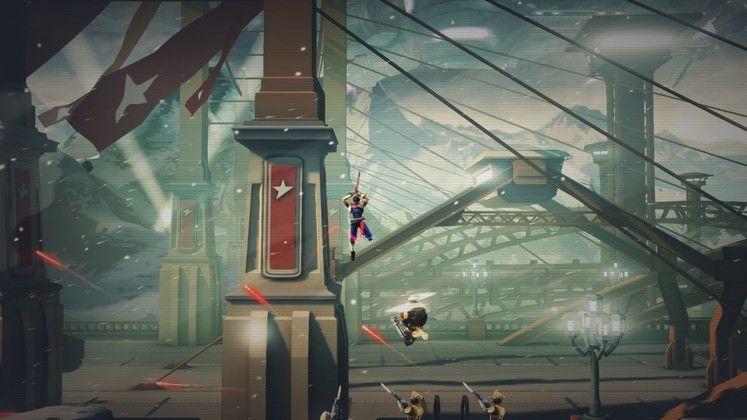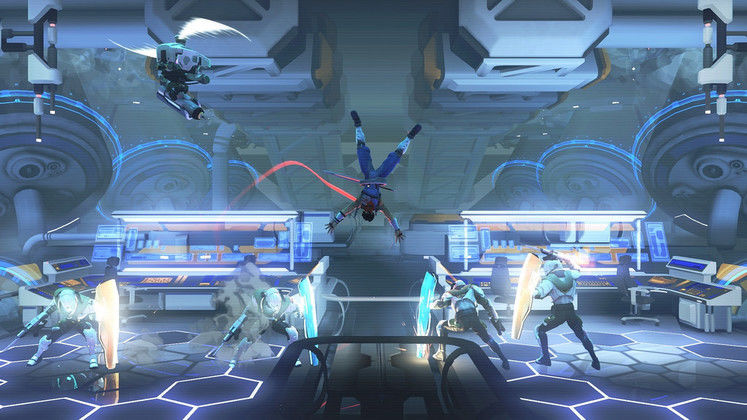It’s not entirely clear where game developers drew their inspiration from in the 1980s. Looking back at Capcom’s original Strider, it’s all somewhat reminiscent of a scene from Aldous Huxley’s darkly satiric A Brave New World, with its looming dictator state, pseudo futuristic flying machines, and lone protagonist forced into rebellion. Don’t get me wrong, it was great fun, but like many of its 80s peers - Space Harrier and Altered Beast, prime examples - it was also a bit mad: level progression was jarring, and it was never really clear what was actually going on. Perhaps the pharmaceutically anaesthetised Bernard Marx of Huxley’s dystopian vision had a hand in the game’s design? Probably not, but what’s clear now is that 2014’s reimagining of Strider adds a little more cohesion to the old story, whilst compromising very little of the good stuff.
 |
| Death from above |
With what appears to be a less than subtle point to prove, the new Strider hits the ground running, all guns blazing, firing on all cylinders, and whatever other relevant speed/capacity related cliche you can think of. It’s fast yet at the same time entirely cool, striking an almost perfect balance for the most part. Immediately following a familiar hand glider descent into Grandmaster Meio’s robot-policed Socialist republic Kazakh City, frontman Strider Hiryu wastes no time in relaying his raison d’etre to player and enemy alike: he’s a cyber ninja and he’s here to kill. A venerable flash of his Cypher sword immediately leaves a pair of automaton foes sprawled out on the concourse, but before their short-circuiting innards hit the floor, our hero has cartwheeled onto the next duo, executing the same lightening speed maneuver to devastating effect. And so Strider sets the pace which it manages to maintain almost from start to finish, doing so whilst retaining the vigor and swagger and red scarf-flailing of the protagonist’s quarter of a century-old predecessor. Best of all - it looks and feels brilliant.
Much similar to his older brother, Strider Hyru is capable of such enemy trouncing acrobatics in concert with a wide range of skills. The only difference this time round is that the ninja’s skill-set must be learned, each individual skill in turn, via the game’s freshly imposed Metroidvania structure; or “gear-gating,” a term which seems to be becoming increasingly popular. At first, Strider’s arsenal is limited, but this is matched by lesser-skilled baddies - largely generic foot soldiers in the opening stages - whereupon enjoying the velocity of the kill is more important than strategy, something which actually never gets old. Health orbs appear in abundance early on too, diminishing only slightly as the game progresses, but with a slew of evenly-spaced checkpoints throughout, back-tracking never really becomes an issue.
Although reluctant to overuse the slightly lazy term ‘Metroidvania’ - Strider is a bloody good one. By adopting such a mechanic, not only can powerups like sword-charging be learned - used to cut through shield-bearing foes - but classic stunts such as Hyru’s signature double jump can also be accrued, adding not only a clever layer of depth to the game, but also a certain level of order - something distinctly lacking in the original. As expected in gear-gating games of this nature, each respective boss battle requires deft use of the previously learned skill - my favourites including the ability to deflect bullets ala Metal Gear Solid’s Grey Fox, and manipulating time portals in order to unlock otherwise inaccessible areas - with completion often unlocking the next in turn. This works well on the whole, however there are the odd occasions where confusing layouts, regardless of the HUD map and pointer icon’s input, lead to lengthy misadventures which terminate at superfluous collector’s items, as opposed to the ‘right way’ - ie the next boss. For a game that relies on - and largely operates in - its fast-action, high-octane sequences, this proves incredibly tedious, placing a needless obstacle between the player and what the game does best.
Another issue with Strider’s setting is its lack of variety. Although integral to the original, Kazakh City wasn’t the game's lone location, as an Amazonian-style jungle and Arctic-inspired snow land also featured. These zones were initially included in early screenshots of the 2014 edition, however were dropped from its final iteration. This leaves certain areas feeling slightly monotonous - particularly in the latter third of the six hour or so quest- only noticeably switching things up upon entering Meio’s headquarters towards the game’s end. This, however, is best portrayed here by a gravity switching sequence, which will more than satisfy those in search of nostalgia.
 |
| This isn't the time for cartwheels |
But what Strider lacks in landscape diversity, it makes up for with deft use of camera angles. Although fixed throughout, the way in which the game switches from close to long range with each scene serves to govern the pace of each battle. With interchangeable camerawork akin to the Oddworld series, bouts viewed from distance tend to be drawn-out, planned affairs, wherein the player is afforded the time to pick and choose which enemies to engage with, traversing walls and ceilings with the strider’s automatically activated grapple hooks; whereas closeups regularly become a mash of sweaty, quick-fire button-bashing until everything on screen has stopped moving.
This dichotomy is perfectly demonstrated furthermore by the ‘challenge’ modes independent to the story campaign, but only unlockable within the main game. In ‘survival mode’, the player is equipped with certain powerups and then pit against several waves of enemies. In ‘beacon run’ players race against the clock to checkpoints, avoiding enemy encounters. Additionally, in replayability terms, Strider’s sole means of ‘scoring’ is defined by how long the player takes to complete the game’s story mode, whereafter each time is allocated a slot on an online scoreboard.
Boss battled are designed to steal center stage, and often do. Each showdown has a sequence which must be understood and then adhered to and followed in order to match each antagonist. That said, some foes can be outdone by simply seizing space and battering the attack button, racing your health bar against theirs. More often than not, following the correct process works best but can at times becomes frustrating, as the difficulty of each boss is less than predictable. How much of a problem this actually is depends on the player, however I saw this balance of challenge and luck more of an homage to the difficulty of the coin-operated games of yore, of which Strider hails from.
 |
| All aboard the dragon express |
Strider is unapologetic in its approach: it’s a Metroidvania that thrives on speed, slashing, and general carnage. It manages all four very well. Story-lite it may be, but it never tries to be otherwise, and a host of bosses and enemies such as mechanical crabs, robotic gorillas, and snaking mechanised Chinese dragons, not to mention an army of drones and Strider-sized soldiers all keep the entertainment flowing. Of course the aforementioned cyber mammals, reptiles and arthropods will likely resonate with existing fans; yet the ferocity of these battles will also appeal to newcomers. And that’s why this Strider works as a ‘remake’ - it clearly is a new game, built from the ground up, but is also laced with sentimentality. Bear in mind the original Strider was introduced as a coin-op arcade game, predating the 90s and a fair whack of the modern market, therefore capturing a new audience is something Double Helix has clearly also set out to do.
Match this with the Californian outfit’s reimagining of Killer Instinct last year, and it would appear they know what they’re doing when reinterpreting the classics. By adopting a Metroidvania-guise here, rather, gear-gating, Double Helix shows that it can in fact teach an old dog new tricks.
STRIDER VERDICT
Match this with the Californian outfit’s reimagining of Killer Instinct last year, and it would appear they know what they’re doing when reinterpreting the classics. By adopting a Metroidvania-guise here, rather, gear-gating, Double Helix shows that it can in fact teach an old dog new tricks.
TOP GAME MOMENT
Air flight by mechanical dragon.




